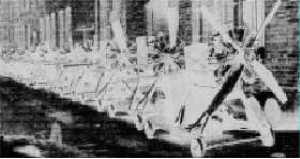Updated: 13-Feb-2020
(See Bentley).
The same company manufactured Clerget 9B engines with 130 hp, and they improved them to 150 hp, thanks to the studies carried out by Bentley. (BR.1).
-That's why, these engines were known as Humber/Bentley.
From Appendix 6: Towards 1917, Humber Ltd. in Coventry was one of the five companies that made the Bentley BR.2.
-Captain Walter Owen Bentley's design was widely used in WWI. The idea was to obtain a lighter and more powerful rotary engine than the existing ones.
-To achieve this, they used aluminum extensively and a more careful design was used. Although based on the Le-Rhone engine.
-It had 9 cylinders and gave 200 hp at 1,300 rpm.

“Humber - Bentley, BR.2”
-This engine in the illustration is the one that is exposed in the engine room at the NASM. It is in need of the carburetor, magneto, some spark plug, vacuum pump and several pusher rods.

“Row of BR.1 engines leaving the Humber factory” (PiP)
Engines of HUMBER - BENTLEY
Model: BR.1
Arquitecture: 9-cylinder Rotary
Cooling: Air
Total Displacement: 1056 cu. in.
Bore / Stroke: 120 x 170 mm
Power: 150 BHP @ 1250 rpm
Weight: 180 Kg
Model: BR.2
Arquitecture: 9-cylinder Rotary
Cooling:
Total Displacement: 1522 cu. in.
Bore / Stroke: 140 x 180 mm
Power: 250 HP
Weight: 220 Kg

"Humber - Bentley, BR.2"


